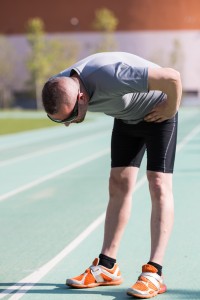I get a wide range of clients in my practice, both for sport nutrition and general wellness. Many are cases of busy people who need simple nutrition strategies to feel better and perform better, either for daily life, or in their sport of choice. But one trend I see perhaps more than any other is athletes who are tired, injured, and struggling with a string of poor performances. They can’t put their finger on what’s wrong, and they are frustrated with what seems like an endless cycle of lost training time and sub-par results.

Low energy availability can not only leave you feeling tired, but prone to injury and illness over time
While not every struggling athlete has the same problem, many do. And, for those who do, it often comes down to something that they might not expect, and that is not how well, but rather, how much they eat. Or, put another way, how much they eat compared with how much they burn. In a world where we are constantly reminded of how easy it is to overeat, it is easy for a highly driven athlete to get caught in the cycle of eating less and training more.
For the record, I’m not talking about someone who is intentionally cutting calories for a short time to meet a weight loss goal, or, on the other end of the spectrum, someone who has developed a full-blown clinical eating disorder. I see my share of those, too, but for many athletes who haven’t been performing well for a while now, the issue boils down to training or exercising with too little gas in the tank for months or even years at a time – not just they days or weeks that a typical diet lasts.
The term for chronically eating less than you are burning is known as having ‘low energy availability’. Energy availability is the amount of energy (measured in calories) your body has leftover to perform its daily functions (like climbing the stairs, walking around, or keeping your heart beating) after you factor in all the energy (measured in calories) burned for training or exercise. Some athletes I work with have an energy availability of close to zero; in other words, virtually every calorie they eat is used to get through training or exercise, leaving the body running on fumes for every other task.
So, what happens if your energy availability is low? If you stop and imagine how your body works, you can probably get a good idea. If you don’t have enough calories for everyday life, your body will start to conserve energy, draw on its reserves, and eventually, break down. Translation? Almost every part of you starts to suffer.
While we know that women who have low energy availability are prone to low bone density (increasing the risk not only for osteoporosis, but also for stress fractures – nasty things that can sap training time and keep athletes out of crucial competitions) and the loss of their menstrual period, we now understand that the effects can be much bigger. We also have good reason to believe low energy availability can also affect men, just perhaps not in as obvious a manner as the loss of a period – for example, via increased injury risk and low testosterone levels.
The term now used by some to explain the far-reaching effects of low energy availability in athletes is Relative Energy Deficiency in Sport, or REDS. REDS was first coined in 2014 as part of an IOC Consensus Report published in the British Journal of Sports Medicine, along with a 2015 update. Since then, it has been the topic of considerable debate in the academic and sports medicine community, some of whom are concerned it is too new to be given a proper name.
Regardless of what you call it, the symptoms of REDS can include fatigue, poor recovery, loss of lean muscle (and often a higher body fat percentage as a result), low mood, lousy sleep, and a compromised immune system. Not surprisingly, performance starts to decline.
Over time, low energy availability can manifest as loss of bone density, stress fractures, and chronic injuries. Headaches, digestive issues, and infertility are also possible. Mentally, the athlete may feel like their sport has become a chore, and yet they often respond by trying to train more, or in some cases, by eating less, all in an attempt to get back to feeling like their old self again. Of course, the effect is often the opposite.
I have seen the effects of low energy availability in athletes and active individuals all the way up the chain, from a busy mom training for her first half-Ironman, to world-class athletes in running, triathlon, gymnastics, and more. I’ve seen countless hours of training and competition lost for both men and women, and exasperated athletes, coaches, and support staff who don’t know how to prevent the next injury.
And that’s part of the secret of REDS: it doesn’t always show up in very thin athletes. Some are normal weight, and I’ve even seen it in overweight athletes. After all, the body is very clever: low energy availability can cause the body to slow down many processes, like reproductive function and bone mineralization, to save energy. So, while weight loss might slow, leading the athlete and coach to believe the athlete is eating enough, the reality is that the body has simply adapted to being chronically underfueled – often with disastrous results.
While the solution to low energy availability seems simple – eat more, and/or train less, the implementation can be tricky. After all, telling a lean marathon runner that he or she might need to add 5 pounds to get healthy again can be stressful, especially when we tell athletes that, when it comes to performance, lighter is often better. It’s easy to lose an athlete (or coach’s) trust in the process.
But once we get an athlete back into energy balance and feeling like themselves again, it is possible to help them find their fighting weight, so to speak. But the difference this time, is that we encourage them to hit their leanest competition form only once or twice per year. We look at the calendar and build their diet plan and body composition plan according to when they need to be at their best. The concept is part of a broader term known as nutrition periodization, which is basically a way of saying that an athlete’s diet can and should change according to their training load, goals, and competitions. And for an athlete who has fallen into the Triad or REDS, learning to periodize their eating and their weight can be the crucial link to get them back into competition successfully.
Are you an athlete or active individual stuck in a cycle of injuries, illness, and declining performance? If so, you would likely benefit from taking a closer look at your diet. If you’re interested in working with a Registered Dietitian who specializes in sports nutrition like myself, please click here to learn more about my one-on-one counselling services.


